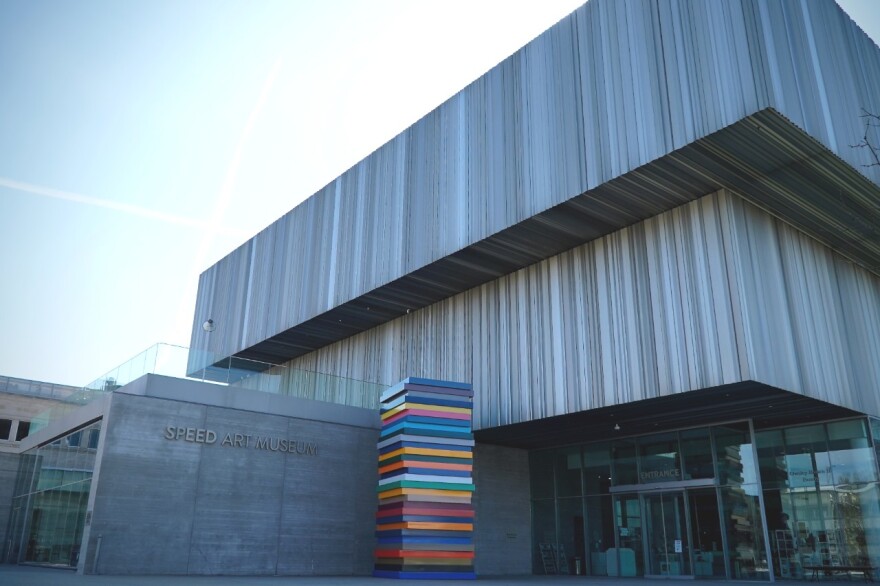Louisville’s Speed Art Museum is undertaking an extensive reinstallation of its art. This is the first time Speed staff has overhauled its permanent collection on this scale since 2016, according to a news release the museum sent out Tuesday.
The effort began in May, as staff started to rearrange its contemporary, European, American, African, Indigenous and Kentucky art collections.
The release said this endeavor will pull 30% more of the museum’s art out of storage, and display some newly acquired works at the Speed for the first time, including pieces by interdisciplinary artist Maia Cruz Palileo, photographer Paul Mpagi Sepuya and contemporary artist Jeffrey Gibson.
In addition to displaying more art, Speed staff are in the process of reinstalling works thematically rather than geographically or chronologically. In a news release, curators say this will provide important cultural context and spark new interpretations.
“This reinstallation is a timely opportunity to reflect on the strengths of our collection and maximize its potential, bringing new works on display for the first time and placing celebrated icons from the canon of art history in conversation with artists working at the forefront of contemporary and historically marginalized traditions,” chief curator Erika Holmquist-Wall, who is leading the reinstallation work, said in the release.
“By breathing life into our collections with fresh perspectives and juxtapositions, we hope to transform the museum experience and inspire new takeaways for visitors,” she continued.
Speed director Raphaela Platow said the effort will elevate “the power of a diverse range of artistic perspectives and build on our commitment to tell stories that matter through our collections and exhibitions.”
Visitors can already see some of this reinstallation work in the contemporary galleries, which reopened last month in a new location, inhabiting walls and spaces on the first floor, near the main entrance.
“I hope to offer visitors the opportunity to enter the museum and immediately come across artworks that speak to the complex social issues of our times as well as the dynamic aesthetic developments in artmaking today,” curator of contemporary art Tyler Blackwell said in the release.
A spokesperson for the museum told WFPL News Speed leadership was motivated, in part, to take on the reinstallation following the 2021 exhibition “Promise, Witness, Remembrance,” which paid tribute to Breonna Taylor.
The museum worked with Taylor’s family and people close to issues like racism and police brutality to develop the show.
After Platow stepped into the role as director last year, she, Holmquist-Wall and, eventually, Blackwell had conversations about how they could re-envision the museum’s permanent collections in a way that is more responsive to themes or subject matter the local community can connect with.
The Speed will also conduct a two-year examination of its Indigenous and African art collections.
The release said the museum intends to work with tribes and communities to learn more about the artwork and show it more thoughtfully.
Museums around the globe have undertaken the work of re-evaluating some of their collections, in particular African and Indigenous artwork, to better understand how the pieces ended up in their collection and their broader backstories. In some cases, the reflection has come from within, while other institutions began the process following public scrutiny. Some museums have begun repatriation processes, returning pieces to the countries they were stolen from.
The topic of museums, collections and something called provenance, basically the history of a work’s ownership, recently caught the attention of television show host John Oliver. In a recent episode of Last Week Tonight, Oliver discussed several ethical issues around western museum collections and auction houses, including problematic approaches to acquisition, reluctance to repatriation and artifacts sitting in storage indefinitely.
“If I could impress one thing on you, it’s that when these objects end up in the West, we put them behind glass and we call them ‘art,’” Oliver said in the Oct. 3 episode. “But in their home context, they can be much more.”
At the Speed, curator of academic engagement and special projects fari nzinga will head the work on its Indigenous and African collections.
“I am looking forward to leading an intentional and thoughtful reinstallation of the Native American and African art galleries to bring them into a cohesive, nuanced and evocative display in conversation with other areas of the collection,” nzinga said.
With the announcement of the reinstallation work, Platow shared that the Speed will resume pre-pandemic hours starting Oct. 21, returning to a five-day-a-week schedule and being open to the public Wednesday through Sunday.


